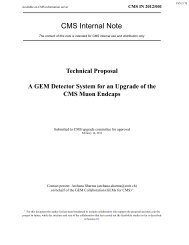Kana et al. 1988. S. Carolina Charleston SLR Case Study
Kana et al. 1988. S. Carolina Charleston SLR Case Study
Kana et al. 1988. S. Carolina Charleston SLR Case Study
Create successful ePaper yourself
Turn your PDF publications into a flip-book with our unique Google optimized e-Paper software.
The n<strong>et</strong> change in areas under the various scenarios listed in Table 2-6 indicates that <strong>al</strong>l<br />
habitats mould undergo significant <strong>al</strong>teration. Even under the baseline scenario, which assumes<br />
historic<strong>al</strong> rates of sea level rise, 20-35 percent losses of representative marsh areas are expected by<br />
2075. Protection under the low scenario (as outlined by Gibbs 1984) mould have virtu<strong>al</strong>ly no effect<br />
on high or low marsh coverage; but it would cause a substanti<strong>al</strong>ly increased loss of transition<br />
w<strong>et</strong>lands. Under the high scenario with protection, highland would be saved at the expense of <strong>al</strong>l<br />
transition and high marsh areas and <strong>al</strong>most 90 percent of the low marsh. Even under the low<br />
scenario, sea level rise would become the dominant cause of w<strong>et</strong>land loss in the <strong>Charleston</strong> area.<br />
RECOMMENDATIONS FOR FURTHER STUDY<br />
This study is a first attempt at d<strong>et</strong>ermining the potenti<strong>al</strong> impact of accelerated sea level rise<br />
on w<strong>et</strong>lands; there remains a need for case studies of other estuaries. Louisiana provides a presentday<br />
an<strong>al</strong>og for the effect of rapid sea level rise on w<strong>et</strong>lands because of high subsidence rates <strong>al</strong>ong<br />
the Mississippi Delta (see Gagliano 1984). Addition<strong>al</strong> studies in that part of the coast should<br />
attempt to document the tempor<strong>al</strong> rate of transformation from marsh to submerged w<strong>et</strong>lands.<br />
Accurate w<strong>et</strong>land transacts with controlled elevations are required to d<strong>et</strong>ermine the<br />
preferred substrate elevations for predominant w<strong>et</strong>land species. With b<strong>et</strong>ter criteria for elevation<br />
and veg<strong>et</strong>ation, we can use remote-sensing techniques and aeri<strong>al</strong> photography to delineate w<strong>et</strong>land<br />
contours on the basis of veg<strong>et</strong>ation. Scenario modeling can then proceed using computer-enhanced<br />
images of w<strong>et</strong>lands and surrounding areas, for more accurate delineation of marsh habitats. Using<br />
historic<strong>al</strong> aeri<strong>al</strong> photos, it may <strong>al</strong>so be possible to infer sedimentation rates by changes in plant<br />
coverage or species type, which could be related to elevation using some of the criteria provided in<br />
this report.<br />
Another problem that remains with this type of study is the frame of reference for mean sea<br />
level. For practic<strong>al</strong> reasons, mean sea level for a standard period (18.6 years gener<strong>al</strong>ly) cannot be<br />
computed until after the period ends. Therefore, fixed references, such as the NGVD of 1929, are<br />
used. But sea level in <strong>Charleston</strong> has an elevation of about 15 cm (NGVD). If everyone uses the<br />
same reference plane for present and future conditions, the problem may be minor. But it does not<br />
<strong>al</strong>low us to d<strong>et</strong>ermine mod<strong>al</strong> elevations with respect to today's sea level. The transacts surveyed<br />
for the present study suggest that S. <strong>al</strong>terniflora (low marsh) grows optim<strong>al</strong>ly at an elevation of 75<br />
cm (2.45 ft) above mean sea level, close to mean high water (U.S. Department of Commerce<br />
1981). Compared with today's mean sea level in <strong>Charleston</strong>, S. <strong>al</strong>terniflora probably tends to grow<br />
as much as 15 cm below actu<strong>al</strong> mean high water, which may confuse the reader who forg<strong>et</strong>s that<br />
the NGVD is 15 cm below today's sea level.<br />
The basic criteria for delineating elevations of various w<strong>et</strong>land habitats in this study can be<br />
easily tested in other areas. By applying norm<strong>al</strong>ized flood probabilities (similar to those depicted<br />
in Figure 2-7), it will be possible to measure marsh transacts in other tide-range areas and relate<br />
them to the results for <strong>Charleston</strong>.<br />
Norm<strong>al</strong>ized Elevations<br />
The absolute mod<strong>al</strong> elevation for each species is site-specific for <strong>Charleston</strong>. Presuming<br />
that the zonation is controlled primarily by tid<strong>al</strong> inundation, it is possible to norm<strong>al</strong>ize the data for<br />
other tide ranges based on frequency curves for each water level. Figure 2-7 contains two such<br />
"tide probability" curves, based on d<strong>et</strong>ailed statistics of Atlantic Coast water levels given in<br />
Ebersole (1982) and summarized in Appendix 2-A. The graph of Figure 2-7A gives the<br />
probability of various water levels for <strong>Charleston</strong>. In Figure 2-7B, the data have been norm<strong>al</strong>ized<br />
51
















